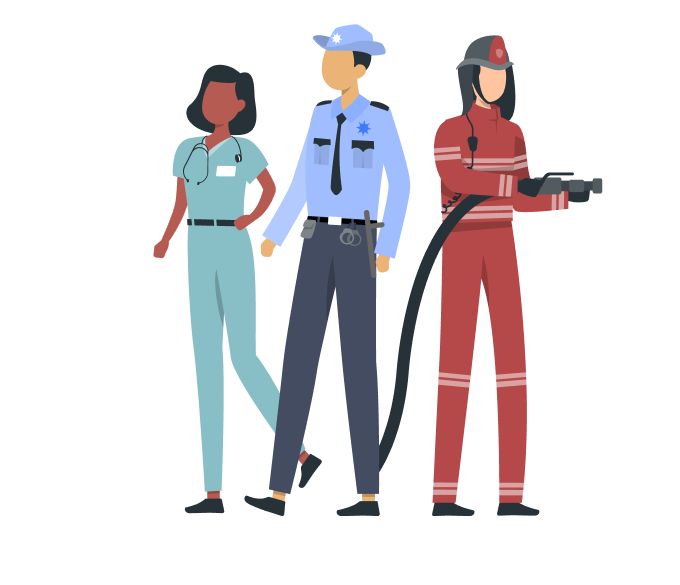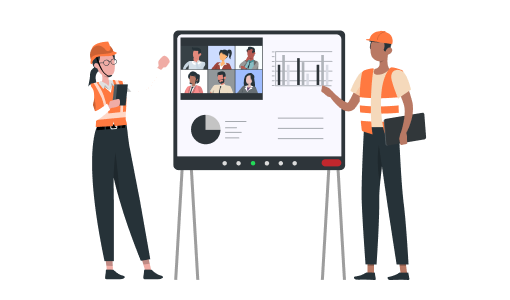Government agencies are evolving the way they serve constituents in the digital era, and public safety agencies are no exception. This guide explores the modernization of today’s public safety capabilities — offering insights on how to utilize Zoom technology to improve communication with field personnel, secure communities, and save lives.
Modernizing Public Safety Services

- 01 Digital transformation for life-saving operations - Jumplink to Digital transformation for life-saving operations
- 02 Elevating in-the-field team support - Jumplink to Elevating in-the-field team support
- 03 Streamlining the work for community well-being - Jumplink to Streamlining the work for community well-being
- 04 Tailored platform options for essential services - Jumplink to Tailored platform options for essential services
Public safety teams are tasked with conducting mission-critical, life-saving activities — managing and deploying emergency services, fire prevention and suppression, search and rescue operations, law enforcement operations, public health services, disaster response, and more. These operations have traditionally involved solutions like landlines, radio equipment, body cameras, physical documentation, and more, all of which have been central to how these teams exchange timely, critical information. But these means of communication can often be slow and unreliable, inhibiting effective communication with people in the field. It’s time for a more modern, integrated approach to technology deployment.
When the COVID-19 pandemic catapulted the public sector into sweeping digital transformation, many had to shed analog processes and embrace a paperless world, with agile collaboration and communications technology at the forefront of the paradigm shift. But teams soon realized that remote and hybrid government services could provide a new avenue for improved conditions — leading to cost savings, improved employee experience, and better protection for the public.
With collaboration technology at the heart of this sweeping digital transformation, providers like Zoom acted as a linchpin for government organizations working to quickly and effectively protect and take care of citizens.
In this guide, you’ll find insights on how to use the Zoom platform for public safety operations to improve outcomes and see how some organizations have already put these techniques into practice.
The in-person element of public safety is the cornerstone of all operations, with in-the-field teams working to save human lives, mitigate disasters, and even extract people from dangerous locations and situations. Technology can’t replace this work, but it can augment and support it.
The strategic application of collaboration technology can create the ultimate human and machine team. By integrating Zoom with drone footage, body cam technology, and other physical on-site components, public safety departments can reduce risk to team members while increasing visibility and situational awareness.
Here are a few ways collaboration technology can support in-the-field teams:
- Informed decision-making for command staff: Using Zoom’s high-quality video, command staff are able to remotely see and hear the conditions of an operation or location in real time, helping command personnel make better-informed decisions. This can reduce cost, increase accuracy, and improve operation outcomes.
- Better support for in-the-field workers: Field personnel, including first responders and military, are able to incorporate insight and intelligence from remote participants through real-time collaboration on Zoom Meetings and Zoom Phone.
- Integration with existing equipment: Command and mission teams have the ability to integrate Zoom with drones and other unmanned systems, existing radio equipment, and devices over a variety of transmission mechanisms, allowing them to access dangerous locations and gain intel without threatening human lives.
- Calls and texting in remote locations: The Zoom platform is optimized for performance in low-bandwidth areas. For Zoom Phone specifically, field personnel can use domestic devices and phone numbers to communicate in areas where data speeds are reduced, even leveraging its SMS feature for text messages.
When lives are on the line, having access to the most up-to-date information and a real-time view of the situation can be critical. The Oceanside Police Department uses remote-controlled drone video, shared via Zoom, to enable command and control visibility for operations conducted by police, first responders, and other emergency personnel. By using Zoom to expedite the way they process and share information, the Oceanside Police Department can save lives, conduct safer operations, and extend capabilities in the areas of search and rescue and public safety.
The Oceanside Police Department
If the past few years have taught us anything, it’s that public health is a fundamental service. Whether it’s local health departments coordinating vaccination efforts or mental health professionals addressing the impact of a global crisis, work on our collective well-being requires the right resources and support to achieve such an important mission.
The Zoom platform enables agile and responsive communications for today’s public health organizations, equipping officials with features designed for seamless and secure collaboration in an environment that supports HIPAA compliance. A few of the ways Zoom can help support public health efforts include:
- Agile phone calls during a crisis: Crisis workers and mental health professionals can use Zoom Phone to take work-related calls on the road for emergency interactions while still maintaining the privacy of their personal number. Crisis workers can also use the call recording feature to keep track of communications that will need a government record.
- Press conferences for spreading awareness: Public health officials can strategically deploy Zoom Webinars to communicate quickly with thousands of constituents on pressing issues, such as vaccination awareness and updates, COVID-19 testing and information, and more. They can also field real-time questions from the public through the webinar Q&A feature or livestream the session on other platforms to spread awareness.
- Coordination across departments: Tasked with conveying ever-evolving health policy, local health departments can quickly meet with schools and other organizations on Zoom Meetings to coordinate efforts and stay in the loop.
- Expanding access to crucial information: Local health organizations can streamline the way they field incoming inquiries from constituents via Zoom Phone’s call queue feature.
- Personalizing care through telehealth: Constituents are now able to engage with health personnel or mental health professionals over video calls, increasing trust, improving the citizen experience, and providing personnel with better insights into real-world conditions.
The Kansas State Department of Corrections is dedicated to supporting a safer Kansas and improving outcomes for incarcerated people. Harold Sass, CIO of Kansas State Department of Corrections, felt strongly that his department’s work for constructive resident culture must “prioritize familial, social, and health-oriented scenarios.”
Leveraging CARES Act funding, he deployed over 60 Zoom Rooms to create learning spaces and help foster digital connections. Zoom Rooms allowed incarcerated mothers to see their children more frequently, even as in-person visits had to be stopped during COVID-19. The team also used Zoom Rooms to support remote substance abuse treatment, create cross-facility resident communities of interest, and sustain telemedicine through a partnership with Centurion Health. Using Zoom to support both mental and physical well-being, Sass was able to pave the way for a more seamless reintegration into society for incarcerated individuals.
Kansas Department of Corrections
Want to discover funding opportunities?
Learn about available stimulus funding and other federal grant programs that can help you modernize IT and telecommunications infrastructure.
Public safety services are essential for citizen well-being and the progress of society as a whole. With such unique responsibilities and demands, today’s public safety agencies need an agile and advanced communications platform that can keep pace. Both Zoom and Zoom for Government are designed to address these specific needs.
In the United States, Zoom offers a separate platform, called Zoom for Government, designed to conform with federal security requirements. Zoom for Government is available to U.S. federal, state, and local government customers, as well as approved government contractors, integrators, or educational institutions that support a government customer. The Zoom for Government platform is U.S.-based and operated by U.S. Persons only.
Zoom for Government delivers an intuitive and secure experience similar to what commercial Zoom users experience. Both versions of the platform are scalable and flexible, giving today’s government organizations the technology they need to achieve their goals while still helping to protect important information shared across the platform.
Zoom for Government has been authorized at the FedRAMP Moderate Level and achieved an authorization to operate with conditions (ATO-C) at Department of Defense Impact Level 4 for Zoom Meetings with the Department of the Air Force. Zoom for Government also supports FIPS 140-2 cryptography, HIPAA compliance, and 300+ NIST controls.





